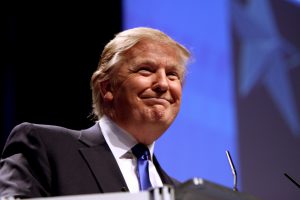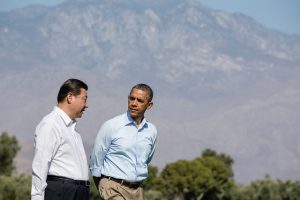President Trump on Tuesday signed an executive order that will trigger a review of the Clean Power Plan, Obama's 2015 policy on limiting emissions from power plants. This policy is essential to helping the US meet its commitment to reduce greenhouse gas emissions under the Paris Agreement. Although the plan was blocked by the courts last year, the new effort to scrap it whilst promoting investment in heavily polluting industries such as coal, is the clearest statement yet that cutting emissions is not a priority for the US administration.
But will the attack on the Clean Power Plan make a difference elsewhere, particularly if it's the first step in an effort by the US to leave the Paris Agreement altogether? We asked Chinese policy experts to weigh in on the issue.
Trade policy rather than political commitment is the key factor – Liu Qiang
Liu Qiang, head of the energy division at the Chinese Academy of Social Science’s Institute of Quantitative and Technical Economics
China has made clear that it will not withdraw from the Paris Agreement, even if the US does, so it will continue to fulfil its commitment to cut [greenhouse gas] emissions. But changes in the US position may present obstacles for implementing a carbon pricing mechanism.
The development of clean power has reached a crucial point: advances in wind and power technology have reduced costs to the point where they can compete to an extent with fossil fuels. The carbon pricing mechanism of the Paris Agreement would make clean energy even more competitive. If the US pulls out that mechanism is at risk and China’s motivation to implement a carbon trading market will be reduced.
A US withdrawal will have more of a symbolic effect, rather than a real impact on specific sectors. The US has never been deeply involved in climate change talks and, moreover, US$2 billion [the amount owed by the US to the United Nation’s Green Climate Fund] is, on a global scale, not that large an amount.
The impact industry and investment will not be huge, and the peak of global investment in clean energy has already passed. Recently, exports of solar modules from China have been hit by EU anti-dumping measures, therefore, [US] trade policy rather than political commitment is the key factor.
No matter how the international situation changes, China will not stop supporting climate governance – Wang Binbin
Wang Binbin, post-doctoral research fellow at Peking University’s School of International Relations
Climate governance is a joint undertaking affecting all humanity. Speaking at Davos recently China’s President Xi Jinping made China’s stance clear: “China will continue to take action in response to climate change and fulfil its duties 100%.”
Foreign Minister Wang Yi, speaking at the G20 Foreign Ministers Meeting in February, stressed the need for cooperation and the creation of a peaceful and stable international environment:
“[We must] establish a UN-led system of cooperation based around North-South cooperation and supplemented with South-South cooperation; and create new types of global development partnerships forming joint development efforts.”
No matter how the international situation changes, China will not stop supporting climate governance and South-South climate governance.
Climate diplomacy has been a bright spot for China-US relations in recent years – Chai Qimin
Chai Qimin, director of the National Centre for Climate Change Strategy and International Cooperation’s (NCSC) International Cooperation Department
If Trump does opt to pull out of the Paris Agreement, there will be a diplomatic impact not just in China, but worldwide.
In 2001 the US refused to sign the Kyoto Protocol. If it now withdraws from the Paris Agreement damage will be done to the UN’s multilateral mechanism. Both the Paris and Kyoto deals were milestones under the 1992 UN Framework Convention on Climate Change; both were programmes for real action; and both made compromises because of US domestic politics.
The Paris Agreement involved intended nationally determined contributions and was specifically designed to facilitate implementation rather than punish failure, and had no legal binding force to a certain extent – all because of the circumstances in the US at the time (i.e. the difficulty in having the treaty ratified by congress).
If the US pulls out it will once more be a case of US internal disputes playing out overseas. This first sets a bad example for other Umbrella Group nations, as when Japan, Australia and Canada withdrew from the Kyoto Protocol; and second, deals a huge blow to the confidence of other countries [in the US as a trustworthy international partner].
China’s energy and climate policy, and its nationally determined contributions, are set according to its own circumstances. Chinese leaders and officials have repeatedly indicated that China is confident in its policies and that the country has its own reasons for a low-carbon transition, which will shore up confidence in multilateral mechanisms. But it is undeniable that more questions are being raised in Chinese government and industry, and that an ambitious green plan will be more difficult to implement than previously – and may even meet scepticism and opposition.
The negative attitude of the US has already affected industry, with clean energy investment sliding last year and low-carbon innovation affected worldwide. Many Chinese new energy firms have seen valuations and borrowing ability fall, and these negative impacts are still emerging. If the remaining US$2 billion promised by the US is not forthcoming the outlook for the Green Climate Fund is bleak.
Climate diplomacy has been a bright spot for China-US relations in recent years, but with the Trump administration coming to power it may be inevitable that such activities become less frequent.
However, there may be a more pragmatic attitude towards energy sector cooperation – for example in shale gas there’s the scope to develop trade, with many benefits for both parties. A lot of work will continue, just not under the banner of climate diplomacy.
Links between China and the US are becoming more diverse, and local governments, businesses and Non-Governmental Organisations will remain active. We refer to these parties as non-governmental stakeholders, and they have a huge role to play. China’s current diplomatic thinking is to expand cooperation as much as possible, rather than oppose it. The Chinese have a saying, that friendliness creates riches. Our new approach is to create new routes to growth and share the benefits of a green transition.
China is also willing to address the concerns of other nations arising from misunderstandings over, for example, transparency; and willing to look for more opportunities for cooperation.
Alongside China-US climate cooperation there are other platforms: China-EU cooperation, the BRICs countries, South-South cooperation. In the past the media preferred to focus on China and the US – the G2. China is currently implementing its 10-100-100 Project [to support adaption and mitigation efforts] and has set up the South-South Cooperation Fund on climate change, both of which are new experiments.
US political changes are irrelevant as China’s existing climate change strategies, targets and actions will not see major changes – Wang Ke
Dr Wang Ke, research fellow at the National Academy of Development and Strategy at Renmin University
China needs to respond to climate change both as part of its own sustainable development, and as a responsible nation. It is not something others are telling us to do, it is something we have to do. In economic terms we are currently faced with a historic task: making our economy yet bigger and better.
This means we need new development pathways for the next 35 years and to carefully avoid creating carbon emissions. China intends to use low-carbon development and its response to climate change to drive increases in total-factor productivity and economic growth; achieve greater energy efficiency; a change in the energy structure; an improved industrial structure; optimisation of income structure and a better-trained workforce, thus fully reinventing our development pathway.
In this sense US political changes are irrelevant as China’s existing climate change strategies, targets and actions will not see major changes, but will be continued. Nor, though, will China be over-ambitious, our actions will align with our abilities and our stage of development.
China and the US are facing very similar challenges with energy efficiency, renewables and the construction or upgrading of infrastructure, and can complement each other in the process of meeting these challenges.
China’s transition to a low-carbon economy will create a huge domestic market for clean energy technologies and products, with large scale demand for the advanced systems, technologies, standards and management practices of the US. By boosting low carbon technology cooperation with China, US firms will be able to able to combine their innovations in technology and business models with China’s world-leading manufacturing ability and huge domestic market.
This will increase the global division of labour, decrease the cost of using low carbon technology, and increase markets for low-carbon technology and products globally. This in turn will reduce greenhouse gas emissions, boost economic prosperity and create jobs in manufacturing. This will encourage the upgrading of infrastructure in the US and make it easier for the US to transition to a low carbon economy and society. Therefore, the Trump administration’s plans for new infrastructure and jobs require more clean energy cooperation with China – this is in the US’s own best interests.







